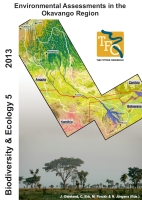Biodiversity & Ecology
Research Article Open Access
A method for yield assessment on rainfed dryland agricultural fields
Keywords: Kavango; Okavango; pearl millet; semi-arid region; southern Africa; subsistence farming
 English
English
Abstract: River flow and inundation of floodplains support a variety of ecosystem services in the Okavango Delta in Botswana. However, river channel desiccation occurs for a number of years or permanently, resulting in adverse impacts on ecosystem services-dependent livelihood activities. This phenomenon is caused by changes in rainfall patterns as well as by shifts in flow distribution due to a number of factors. This study has investigated the relationship between adaptation to desiccation and ecosystem services which support livelihoods in the Okavango Delta. Research methods included the use of aerial photographs and satellite images, household survey, focus group discussions, hydrological modelling and the construction of scenarios on socio-economic impacts of desiccation. The results of the study showed that desiccation adversely affects various livelihood activities, particularly those based on ecosystem services such as flood recession agriculture, livestock farming and veld products collection. It is further revealed that this phenomenon is likely to increase in frequency and intensity in the future as a result of climate change. The paper posits that adaptation policies which support diversification of livelihood activities into those which are less dependent on ecosystem services should be promoted.Within the Okavango catchment, subsistence agriculture is the predominant land use and the main livelihood activity of roughly 86.500 persons. However, knowledge about smallholder crop yields on the local level is sparse or missing but will be of high importance in manifold ways within the TFO-Project as central tasks are multidisciplinary research on soil fertility (soil sciences and economics), evaluation of conservation agriculture methods, calculation of net primary production for carbon balance calculations and incorporation in future land use scenarios. A specific method for yield assessment has been elaborated and tested. Sampling took place during the harvest season of April and Mai 2012 on 26 smallholder-owned fields in the Mashare region in northern Namibia on dryland agricultural fields. On a homogeneous part of a field (=sampling area) regarding land use history, sowing date and fertilizer use, the distance between two diagonal opposite corners was measured and five plots of 2 m x 2 m size were evenly distributed along that line. All plants on each plot were sampled and after drying the yield and plants biomass were measured. A direct and an indirect method for the quantification of grain yield were compared. Results show, that on all fields the main crop was pearl millet (Pennisetum glaucum). The mean dry biomass was 1.46 ± 0.86 Mg ha-1. From 19 fields where no crops were harvested at the moment of sampling, direct measured mean yield was 161 ± 76 kg ha-1. From the dry biomass of cobs calculated data resulted in a mean yield of 155 ± 122 kg ha-1. Neither field age nor landscape unit and thus nutritional status did have an influence on the amounts of yields. A possible explanation for that is that the influence of spatially high variable rainfall can overshadow all other factors. However the yield values are in line with findings from the literature for dryland agriculture fields.
 Portuguese
Portuguese
Título: Um método para a avaliação de rendimento em campos agrÃcolas de sequeiro
Palavras-chave: Ãfrica Austral; agricultura de subsistência; milheto; Kavango; Okavango, região semiárida
Resumo: Dentro da bacia do Okavango, a agricultura de subsistência é o uso predominante da terra e a principal atividade de aproximadamente 86.500 pessoas. No entanto, o conhecimento sobre o rendimento das culturas de pequenos agricultores, em nÃvel local, é escasso ou inexistente, mas será de grande importância de diversas formas dentro do projeto TFO, visto que as principais tarefas são a pesquisa multidisciplinar sobre a fertilidade do solo (ciências do solo e economia), a avaliação dos métodos de agricultura de conservação, o cálculo da rede de produção primária para o cálculo do balanço de carbono e a incorporação em futuros cenários de uso do solo. Um método especÃfico para a avaliação de rendimento foi elaborado e testado. A amostragem ocorreu durante a época da colheita de abril e maio de 2012, em 26 campos de propriedade de pequenos agricultores na região do Mashare, norte da NamÃbia, em campos agrÃcolas de sequeiro. Em uma parte homogênea de um campo (= área de amostragem), com relação ao histórico do uso do solo, à data da semeadura, ao uso de fertilizantes e à distância entre dois cantos diagonais opostos foram mensurados e cinco parcelas de 2 m x 2 m foram distribuÃdas uniformemente ao longo dessa linha. Todas as plantas de cada parcela foram utilizadas como amostras e após a secagem seu rendimento e biomassa foram mensurados. Foram comparados métodos direto e indireto para a quantificação da produção agrÃcola de grãos. Os resultados mostram que em todos os campos a cultura principal foi o milheto (Pennisetum glaucum). A biomassa seca média foi de 1,46 ± 0,86 Mg ha-1. Dos 19 campos onde as lavouras não foram colhidas no momento da amostragem, o rendimento médio direto medido foi de 161 ± 76 kg ha-1. A partir da biomassa seca de espigas, dados calculados resultaram em uma produtividade média de 155 ± 122 kg ha-1. Nem a idade, nem a unidade de paisagem e, portanto, o estado nutricional, teve influência sobre as quantidades de produção. Uma possÃvel explicação para isso é que a influência espacialmente alta de pluviosidade variável pode ofuscar todos os outros fatores. No entanto, os valores de rendimento estão em conformidade com os resultados da literatura para os campos de agricultura de sequeiro.
Suggested citation:
Gröngröft, A., Luther-Mosebach, J., Landschreiber, L., Kowalski, B. (2013): A method for yield assessment on rainfed dryland agricultural fields. – In: Oldeland, J., Erb, C., Finckh, M., Jürgens, N. [Eds.]: Environmental Assessments in the Okavango Region. – Biodiversity & Ecology 5: 279â286. DOI: 10.7809/b-e.00281.


